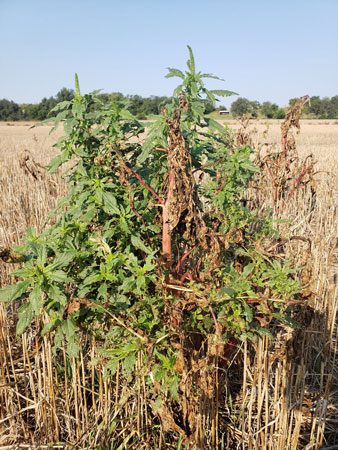Post-harvest weed control in wheat stubble is very important to conserve soil moisture and prevent weeds from going to seed and adding to the weed seedbank that must be managed in future years. Weeds can grow quickly once the wheat canopy is removed and can easily become difficult to manage, especially in the hot, dry conditions of summer. The species that are often targeted with post-harvest herbicide applications are often Palmer amaranth and kochia; however, controlling volunteer wheat is also an important objective for these applications (Figure 1).

Figure 1. Palmer amaranth and volunteer wheat can quickly emerge once the wheat canopy is removed at harvest. Photo by Sarah Lancaster, K-State Research and Extension.
Historically, the key herbicides for weed control in wheat stubble were glyphosate plus 2,4-D and/or dicamba. However, the development of herbicide resistant weeds has reduced the effectiveness of these products. Higher rates of 2,4-D and dicamba may improve control, but it is important to consider other options, especially those with residual activity on key species like pigweeds and kochia. Some options are described in the next paragraphs of this article.
Gramoxone (paraquat) is a non-selective, contact herbicide that can be used in fallow fields. It should be applied at 0.5 to 1.0 pounds of paraquat/A, which is equal to 2 to 4 pints of GramoxoneSL 2.0 or 1.3 to 2.7 pints of GramoxoneSL 3.0. Thorough spray coverage is important for good control, which means medium to coarse droplet sizes and greater spray volumes (20 GPA or more). Gramoxone should be applied with NIS, COC, or MSO. Because paraquat is a contact herbicide regrowth is common, especially of large weeds (Figure 2). Adding a Group 5 herbicide, such as atrazine or metribuzin can enhance control of larger weeds and add some residual activity. Atrazine will also help control volunteer wheat. It’s also important to remember that paraquat is a restricted use pesticide that requires additional training for handling.

Figure 2. This large Palmer amaranth is re-growing after being sprayed with paraquat. Photo by Sarah Lancaster, K-State Research and Extension.
Sharpen (saflufenacil) is a Group 14 herbicide that is a primarily a contact herbicide but also provides some residual activity. Use 2 to 3 oz/A for larger weeds and residual activity. Sharpen works best with the addition of methylated seed oil. Sharpen requires complete coverage so using 15 to 20 gallons/acre spray solution is important.
Valor (flumioxazin) can provide contact and residual activity of key species like pigweeds. Valor EZ can be applied at 2 to 4 fl oz/A. Crop rotation should be considered when selecting the application rate. The 4 fl oz rate has a 4-month rotation interval for corn, cotton, sorghum, soybean, sunflower, and wheat; but lower rates have fewer restrictions. If targeting emerged weeds, NIS or COC should be included in the application.
All herbicides are most effective when applied to weeds that are actively growing. This means it is necessary to wait for a at least 2-3 inches of regrowth if weeds were cut off by the combine. It may be tempting to wait further delay applications to wait for later weed flushes; however, consider including a product with residual activity, rather than waiting, in order to prevent poor control of large weeds.
Additional information can be found in the 2021 Chemical Weed Control for Field Crops, Pastures, Rangeland, and Noncropland, K-State publication SRP-1162.
The use of trade names is for clarity to readers and does not imply endorsement of a particular product, nor does exclusion imply non-approval. Always consult the herbicide label for the most current use requirements.
Sarah Lancaster, Weed Science Extension Specialist
slancaster@ksu.edu
Tags: weed control kochia palmer amaranth volunteer wheat post-harvest